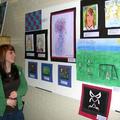In 1999, five school principals approached officials at the John F. Kennedy Center for the Performing Arts in Washington. They asked for help to establish a school-wide focus on integrating arts into their schools' teachings. The schools and the Kennedy Center — which in addition to being a performing arts center is a national cultural and educational institution — worked together to design the Changing Education through the Arts program. Today, the program offers a model for both arts integration in schools and professional development for teachers.
What is arts integration? When they began, knowing how to answer that question was the biggest challenge for teachers. One answer led to a new way of learning for students at Bailey's Elementary School in Fairfax County, Virginia. The school's third-grade students first explored concepts and vocabulary shared by dance and science. They also studied energy, patterns and cycles, and then they created a dance that applied their experience.
Fourth-grade students at Bailey's read and discussed information about slavery abolitionists and then engaged in activities such as analyzing slavery themes in visual art, writing poems and staging a short theatrical performance. Controlled comparison studies have shown that students participating in the program show significant improvement in academic achievement not related to art — including test scores in English and history — and student effort has also increased, according to the school district's Web site. As of 2008, 10 Fairfax County schools with over 4,700 students were participating in the program.
Today, at most of the participating schools, the program has reached a new level, according to school officials. Many teachers are integrating arts with other subjects on a regular basis. They are also collaborating more with each other and especially with arts specialists at their schools. Student engagement and motivation to learn has risen. English-language learners and special education students benefit even more from arts integration.
Teachers not already at a participating school can take courses or workshops led by experienced teaching artists at the Kennedy Center. The center offers about 60 courses and workshops as part of the program. Teachers usually attend as a team, participating in courses that focus on integrating dance, drama, music, visual arts, poetry and storytelling with language arts, social studies, science and mathematics.
The arts integration program continues to evolve and expand. Right now, there is a waiting list of schools interested in joining. The Kennedy Center just hosted a national conference with school representatives from across the country. The conference included tips on how each school can modify the program so that it can be successful in local situations.
No matter how a school structures its program, ultimately it's all about helping students learn.

